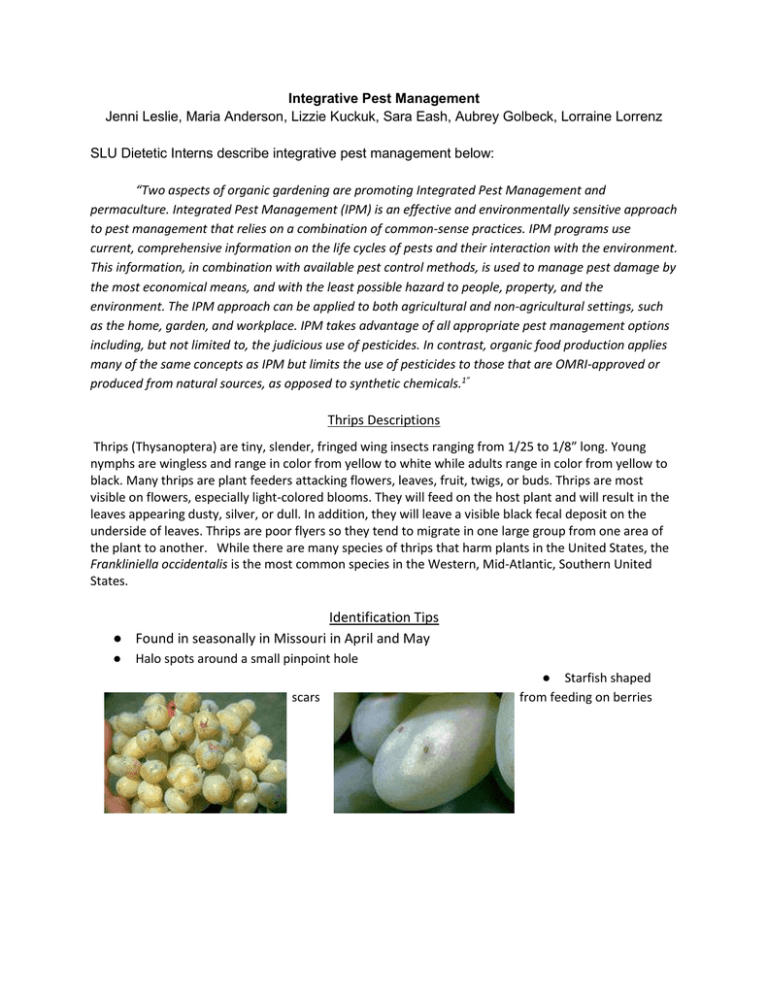Week 7 Thrips
advertisement

Integrative Pest Management Jenni Leslie, Maria Anderson, Lizzie Kuckuk, Sara Eash, Aubrey Golbeck, Lorraine Lorrenz SLU Dietetic Interns describe integrative pest management below: “Two aspects of organic gardening are promoting Integrated Pest Management and permaculture. Integrated Pest Management (IPM) is an effective and environmentally sensitive approach to pest management that relies on a combination of common-sense practices. IPM programs use current, comprehensive information on the life cycles of pests and their interaction with the environment. This information, in combination with available pest control methods, is used to manage pest damage by the most economical means, and with the least possible hazard to people, property, and the environment. The IPM approach can be applied to both agricultural and non-agricultural settings, such as the home, garden, and workplace. IPM takes advantage of all appropriate pest management options including, but not limited to, the judicious use of pesticides. In contrast, organic food production applies many of the same concepts as IPM but limits the use of pesticides to those that are OMRI-approved or produced from natural sources, as opposed to synthetic chemicals.1” Thrips Descriptions Thrips (Thysanoptera) are tiny, slender, fringed wing insects ranging from 1/25 to 1/8” long. Young nymphs are wingless and range in color from yellow to white while adults range in color from yellow to black. Many thrips are plant feeders attacking flowers, leaves, fruit, twigs, or buds. Thrips are most visible on flowers, especially light-colored blooms. They will feed on the host plant and will result in the leaves appearing dusty, silver, or dull. In addition, they will leave a visible black fecal deposit on the underside of leaves. Thrips are poor flyers so they tend to migrate in one large group from one area of the plant to another. While there are many species of thrips that harm plants in the United States, the Frankliniella occidentalis is the most common species in the Western, Mid-Atlantic, Southern United States. Identification Tips ● Found in seasonally in Missouri in April and May ● Halo spots around a small pinpoint hole scars ● Starfish shaped from feeding on berries Integrative Pest Management Plan There are several organic pest treatments to use for thrips. These include: ● Knock off thrips with a forceful spray of water. This technique is most effective in the morning and may need to be repeated for 3 treatments administered either everyday or every other day. Be sure to spray the underside of leaves as well. ● Keep plants well irrigated. Thrips prefer a dry environment, so keeping the plants wet and misting often helps to deter the pests. ● Prune/destroy infected plants. ● Attract and protect the insects that feed on thrips. Spiders, mites, and pirate bugs will help control thrips without the use of chemicals. ● Soaps and sprays. These options are not organic. Treatments with imidacloprid (Merit), acephate (Orthene), bifenthrin, imidacloprid, or spinosad may be helpful against these pests. ● Organic spray: Naturalis-O. Naturalis-O contains the spores of Beauveria bassiana ATCC 74040. The pests that this spray is effective on include whiteflies, thrips, aphids, fungus gnats, and shore flies. Naturalis-O works on contact with the plant and must attach to the insect to be effective, so adequate spraying is important. Once the spores have attached to the insects, mortality will occur in 3-5 days. For larger infestations, repeated application of spray every 3-5 days may be necessary to gain control of the pests. References 1. Maxbauer, H. et al., “Week 5 - Culinary Camp Integrative Pest Management: Urban Garden/Fruit Trees” St. Louis University, St. Louis, MO. July 21st, 2015. 2. "Thrips." Missouri Botanical Garden, n.d. from http://www.missouribotanicalgarden.org Retrieved: 21 July 2015 3. NaturalisⓇ-O: Biological Insecticide. http://www.ohp.com/PIB/PDF/naturalis_o_525_pib.pdf. Retrieved June 21, 2015.


